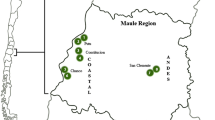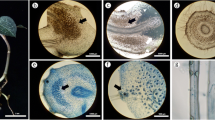Abstract
The seed germination of orchids under natural conditions requires association with mycorrhizal fungi. Dendrobium nobile and Dendrobium chrysanthum are threatened orchid species in China where they are considered medicinal plants. For conservation and application of Dendrobium using symbiosis technology, we isolated culturable endophytic and mycorrhizal fungi colonized in the protocorms and adult roots of two species plants and identified them by morphological and molecular analyses (5.8S and nrLSU). Of the 127 endophytic fungi isolated, 11 Rhizoctonia-like strains were identified as Tulasnellales (three strains from protocorms of D. nobile), Sebacinales (three strains from roots of D. nobile and two strains from protocorms of D. chrysanthum) and Cantharellales (three strains from roots of D. nobile), respectively. In addition, species of Xylaria, Fusarium, Trichoderma, Colletotrichum, Pestalotiopsis, and Phomopsis were the predominant non-mycorrhizal fungi isolated, and their probable ecological roles in the Dendrobium plants are discussed. These fungal resources will be of great importance for the large-scale cultivation of Dendrobium plants using symbiotic germination technology and for the screening of bioactive metabolites from them in the future.




Similar content being viewed by others
References
Bayman P, Lebrón LL, Tremblay RL, Lodge DJ (1997) Variation in endophytic fungi from roots and leaves of Lepanthes (Orchidaceae). New Phytol 135:143–149
Bayman P, Gonzalez EJ, Fumero JJ, Tremblay RL (2002) Are fungi necessary? How fungicides affect growth and survival of the orchid Lepanthes rupestris in the field. J Ecol 90:1002–1008
Bidartondo M, Read DJ (2008) Fungal specificity bottlenecks during orchid germination and development. Mol Ecol 17:3707–3716
Brundrett MC, Scade A, Batty AL, Dixon KW, Sivasithamparam K (2003) Development of in situ and ex situ seed baiting techniques to detect mycorrhizal fungi from terrestrial orchid habitats. Mycol. Res. 107(10):1210–1220
Cannon PF, Simmons CM (2002) Diversity and host preference of leaf endophytic fungi in the Iwokrama Forest Reserve, Guyana. Mycologia 94:210–220
Chen XM, Guo SX (2005) Effects of four species of endophytic fungi on the growth and polysaccharide and alkaloid contents of Dendrobium nobile. China J Chin Mater Med 30(4):253–257
Chen XM, Dong HL, Hu KX, Sun ZR, Chen J, Huo SX (2010) Diversity and antimicrobial and plant-growth-promoting activities of endophytic fungi in Dendrobium loddigesii Rolfe. J Plant Growth Regul 29:328–337
Cribb PJ, Lell SP, Dixon KW, Barrett RL (2003) Orchid conservation: a global perspective. In: Dixon KW, Kell SP, Barrett RL, Cribb PJ (eds) Orchid conservation. Natural History Publications, Kota Kinabalu, pp 1–24
Dearnaley JDW (2007) Further advances in orchid mycorrhizal research. Mycorrhiza 17:475–486
Goh CJ, Sim AA, Lim G (1992) Mycorrhizal associations in some tropical orchids. Lindleyana 7:13–17
Hennigan T (2009) Toward a biblical basis for ecology, with applications in mycorrhizal symbioses in orchids. J Creat 23:78–85
Hou XQ, Guo SX (2009) Interaction between a dark septate endophytic isolate from Dendrobium sp. and roots of D. nobile seedlings. J Integr Plant Biol 51:374–381
Johnson TR, Stewart SL, Dutra D, Kane ME, Richardson L (2007) Asymbiotic and symbiotic seed germination of Eulophia alta (Orchidaceae)—preliminary evidence for the symbiotic culture advantage. Plant Cell Tiss Org Cult 90:313–323
Kristiansen KA, Taylor DL, Kjoller R, Rasmussen HN, Rosendahl S (2001) Identification of mycorrhizal fungi from single pelotons of Dactylorhiza majalis (Orchidaceae) using single-strand conformation polymorphism and mitochondrial ribosomal large subunit DNA sequences. Mol Ecol 10:2089–2093
Leake JR (1994) The biology of myco-heterotrophic (saprophytic) plants. New Phytol 127:171–216
McKendrick SL, Leake JR, Taylor DL, Read DJ (2000) Symbiotic germination and development of myco-heterotrophic plants in nature: ontogeny of Corallorhiza trifida and characterization of its mycorrhizal fungi. New Phytol 145:523–537
McKendrick SL, Leake JR, Taylor DL, Read DJ (2002) Symbiotic germination and development of the mycoheterotrophic orchid Neottia nidus-avis in nature and its requirement for locally distributed Sebacina spp. New Phytol 154:233–247
Nontachaiyapoom S, Sasirat S, Manoch L (2010) Isolation and identification of Rhizoctonia-like fungi from roots of three orchid genera, Paphiopedilum, Dendrobium, and Cymbidium, collected in Chiang Rai and Chiang Mai provinces of Thailand. Mycorrhiza 20:459–471
Nylander JAA (2002) MrModeltest. Department of Systematic Biology, Uppsala University, Uppsala
Otero JT, Ackerman JD, Bayman P (2002) Diversity and host specificity of endophytic Rhizoctonia-like fungi from tropical orchids. Am J Bot 89:1852–1858
Pharmacopoeia Committee of the P. R. China (2005) Pharmacopoeia of the People’s Republic of China (vol.1). People's Medical Publishing House, Beijing
Porras-Alfaro A, Bayman P (2007) Mycorrhizal fungi of Vanilla: diversity, specificity and effects on seed germination and plant growth. Mycologia 99:510–525
Rasmussen HN (2002) Recent developments in the study of orchid mycorrhiza. Plant Soil 244:149–163
Rasmussen HN, Whigham DF (1993) Seed ecology of dust seeds in situ: a new study technique and its application in terrestrial orchids. Am J Bot 80:1374–1378
Roberts P (1999) Rhizoctonia-forming fungi. A taxonomic guide. The Herbarium, Royal Botanic Gardens, Kew. ISBN 1 900347695
Sánchez MS, Bills GF, Zabalgogeazcoa I (2008) Diversity and structure of the fungal endophytic assemblages from two sympatric coastal grasses. Fungal Divers 33:87–100
Sharma J, Zettler LW, Van Sambeek JW, Ellerieck MR, Starbuck CJ (2003) Symbiotic seed germination and mycorrhizae of the federally threatened Platanthera praeclara (Orchidaceae). Am Midl Nat 149:104–120
Shefferson RP, Weiß M, Kull T, Taylor DL (2005) High specificity generally characterises mycorrhizal association in rare lady’s slipper orchids, genus Cypripedium. Mol Ecol 14:613–626
Smith SE, Read DJ (2008) Mycorrhizal symbiosis, 3rd edn. Academic, San Diego
Stewart SL, Kane ME (2006) Symbiotic seed germination of Habenaria macroceratitis (Orchidaceae), a rare Florida terrestrial orchid. Plant Cell Tissue Organ Cult 86:159–167
Stone JK, Bacon CW, White JF (2000) An overview of endophytic microbes: endophytism defined. In: Bacon CW, White JF (eds) Microbial endophytes. Marcel Dekker, New York, pp 3–29
Strobel GA (2002) Rainforest endophytes and bioactive products. Crit Rev Biotechnol 22:315–333
Suárez JP, Weiss M, Abele A, Garnica S, Oberwinkler F, Kottke I (2006) Diverse tulasnelloid fungi from mycorrhizas with epiphytic orchids in Andean cloud forest. Mycol Res 110:1257–1270
Suárez JP, Weiß M, Andrea A, Oberwinkler F, Kottke I (2008) Members of Sebacinales subgroup B form mycorrhizae with epiphytic orchids in a neotropical mountain rain forest. Mycol Prog 7:75–85
Swofford DL (2002) PAUP*. Phylogenetic Analysis Using Parsimony (*and other methods), 4.0b4a. Sunderland, Massachusetts
Thompson JD, Gibson TJ, Plewniak F, Jeanmougin F, Higgins DG (1997) The Clustal X windows interface: flexible strategies for multiple sequence alignment aided by quality analysis tools. Nucleic Acids Res 25:4876–4882
Wang H, Fang HY, Wang YQ, Duan LS, Guo SX (2011) In situ seed baiting techniques in Dendrobium officinale Kimuraet Migo and Dendrobium nobile Lindl.: the endangered Chinese endemic Dendrobium (Orchidaceae). World J Microbiol Biotechnol. doi:10.1007/s11274-011-0667-9
Warcup JH, Talbot PHB (1967) Perfect states of Rhizoctonias associated with orchids. New Phytol 66:631–641
White TJ, Bruns T, Lee S, Taylor J (1990) Amplification and direct sequencing of fungal ribosomal RNA genes for phylogenetics. In: Innis MA, Gelfand DH, Sninsky JJ, White TJ (eds) PCR protocols: a guide to methods and applications. Academic, San Diego, pp 315–322
Xing YM, Chen J, Cui JL, Chen XM, Guo SX (2011) Antimicrobial activity and biodiversity of endophytic fungi in Dendrobium devonianum and Dendrobium thyrsiflorum from Vietnam. Curr Microbiol 62:1218–1224
Xu JT, Mu C (1990) The relation between growth of Gastrodia elata protocorms and fungi. Acta Bot Sin 32:26–31
Yuan Z, Chen Y, Yang Y (2009) Diverse non-mycorrhizal fungal endophytes inhabiting an epiphytic, medicinal orchid (Dendrobium nobile): estimation and characterization. World J Micribiol Biotechnol 25:295–303
Yukawa T, Ogura-Tsujita Y, Shefferson RP, Yokoyama J (2009) Mycorrhiza diversity in Apostasia (Orchidaceae) indicates the origin and evolution of orchid mycorrhiza. Am J Bot 96:1997–2009
Zettler LW, Poulter SB, McDonald KI, Stewart SL (2007) Conservation-driven propagation of an epiphytic orchid (Epidendrum nocturnum) with a mycorrhizal fungus. Hort Sci 42:135–136
Acknowledgments
This investigation was supported by the National Natural Science Foundation of China (30900004, 30770068), National High Technology Research and Development Program of China (2008AA09Z405), and National S & T Major Special Project on Major New Drug Innovation (2009ZX09301-003-3-3).
Author information
Authors and Affiliations
Corresponding author
Rights and permissions
About this article
Cite this article
Chen, J., Wang, H. & Guo, SX. Isolation and identification of endophytic and mycorrhizal fungi from seeds and roots of Dendrobium (Orchidaceae). Mycorrhiza 22, 297–307 (2012). https://doi.org/10.1007/s00572-011-0404-0
Received:
Accepted:
Published:
Issue Date:
DOI: https://doi.org/10.1007/s00572-011-0404-0




